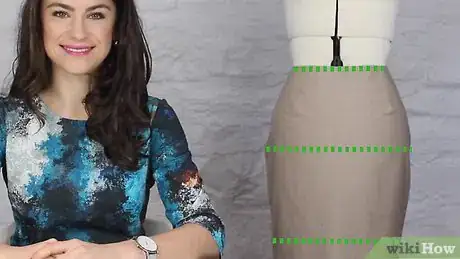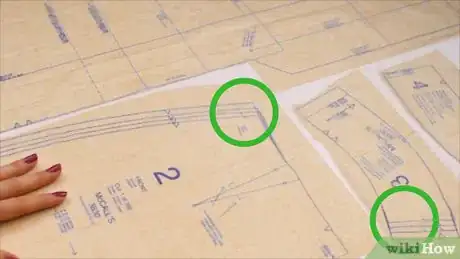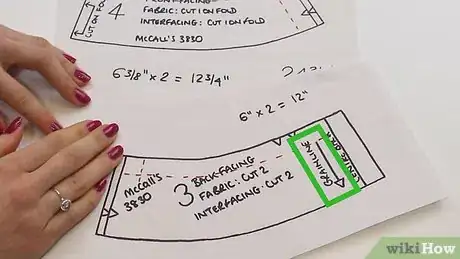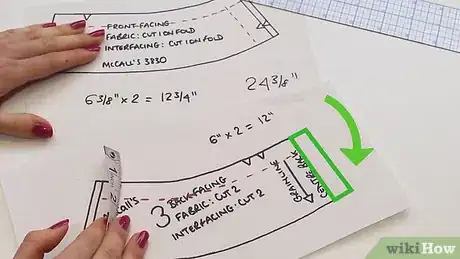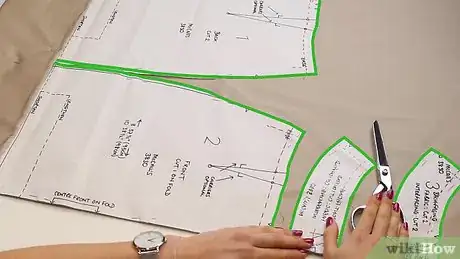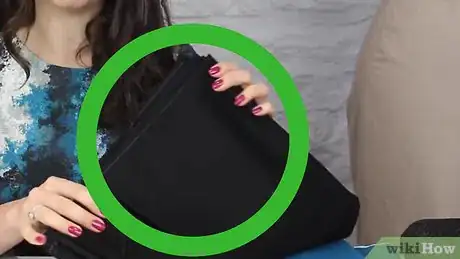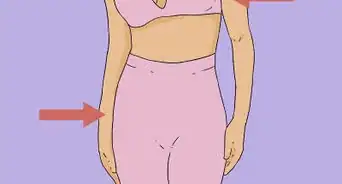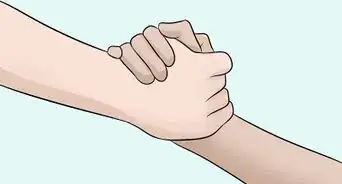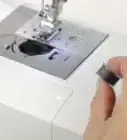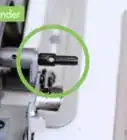This article was co-authored by Kpoene Kofi-Bruce. Kpoene Kofi-Bruce is a tailor, couture wedding gown designer, and the Creative Director of Mignonette Bridal and Ette the Wedding Tailor in Chicago, Illinois. With nearly two decades of experience as a wedding gown designer, small business owner, and vintage sewing enthusiast, Kpoene specializes in wedding gown design and the social history of wedding dresses. She received a BA in Creative Writing from Middlebury College and studied the business of fashion at the Fashion Institute of Technology. She is also a graduate of the Goldman Sachs 10KSB program and the Chicago Fashion Incubator and has written about wedding fashion for Jezebel, Catalyst, the Sun Times, and XO Jane.
There are 7 references cited in this article, which can be found at the bottom of the page.
wikiHow marks an article as reader-approved once it receives enough positive feedback. This article received 11 testimonials and 100% of readers who voted found it helpful, earning it our reader-approved status.
This article has been viewed 932,567 times.
After learning to sew, it's a natural step to learning to sew with a pattern. Being able to sew using a pattern will provide you with many options for creating garments, costumes, soft furnishings, toys, and other items that can be sewn. This article explains how to sew using patterns.
Steps
Choosing Your Size
-
1Select the right size for the person who will wear the garment. If it's for you, have a friend measure you first. Do keep in mind that the units you choose for measurement should not change as it may cause confusion while stitching. Remember, it will not necessarily be the same size as the ready-to-wear clothing you already own, as pattern sizing can vary considerably from what you're used to wearing. Look on the back of the pattern envelope and determine your size by the "finished" measurements it provides.
- Most pattern companies follow an international code for sizes.[1]
-
2Watch out for multi-sized patterns. Some patterns are multi-sized. This means that they will be suitable for a wide range of sizes, although they'll usually still provide an indication of the size range. You'll need to look at the pattern itself for the markings of where to cut for each size.Advertisement
-
3Leave space for alterations.[2] All patterns contain an allowance for fit, known as "fit or wearing ease", or "designer ease", assuming they are designed for fabrics that require this allowance.[3] The allowance is not included for garments designed for knit fabrics since these fabrics have natural stretch. Read the instructions on your pattern to find the allowance or look on the pattern itself for "finished" measurements, or something similar.
- Compare the difference between the finished measurements and your body measurements in order to find the allowance.
- If you don't want the allowance that is included, or if you want to make it smaller or larger, you'll need to look out for this.
- This allowance will determine what the final size is for the garment, and indicates whether the garment will fit loosely or closely. Some companies have a standard allowance that corresponds to the descriptions (loose-fitting, fitted, etc.).
- For beginners it is probably better to ignore all of this, as you may not be ready to alter patterns. If you're unsure, leave in the allowance and take the final garment to a tailor.
Reading the Pattern
-
1Read the directions.[4] Every pattern comes with step-by-step instructions on a separate sheet (user guide), as well as the pattern template sheet (pattern tissue). You should always read the instructions in the user guide before starting the sewing project so that you're aware of what's expected.
- The advice will include how to cut out the template sheet (pattern tissue), how to construct the garment or item, the best way to select sizing, etc.
-
2Check for seam allowances. Check the pattern instructions to find out if the pattern is with or without seam allowances. If it does not include seam allowances, you'll need to cut the fabric with the seam allowances later. It is more normal for seam allowances not to be included.
-
3Notice the grain lines.[5] This is a long straight line with arrow heads at one or both ends. This arrow tells you which direction the paper pattern pieces should sit over the grain of the weave (which direction the grain of the fabric needs to go). For stretch fabrics, they might indicate the direction with most stretch.
- The grain line of the fabric is the same as the direction of the selvage edges (the white edge where the pattern ends). Simply locate the selvage edge to determine the grain line or direction of the fabric.
-
4Look for the notches. These are the triangular marks on the cutting lines. Use them for matching panels precisely, such as an arm in an armhole. You can get single, double, and triple notches. Pros will make tiny cuts into the seam allowance where these notches are but beginners should cut mirrored triangles beyond the cut line, in order to line up the pattern pieces.
- Usually a single notch indicates the front of a garment while a double notch indicates the back. This is not universal, however.[6]
-
5Find the dots. These little circles can show where darts, zips, pockets, or gatherings are to be added, though they usually indicate where you need to place tacks in order to line up two layers of fabric. Refer to your pattern instructions if you are unsure.
- If the pattern does not explain and you see two matching dots on opposite pieces of the pattern, then it is reasonable to assume that these two match up.
- Zipper lines are almost always indicated with a zig-zag line.
-
6Look for button markings. Button placement is usually shown with an X, while buttonholes are marked with a bracket line (like the number lines you drew in your math classes), marking the actual size of the buttonhole.
-
7Look for lengthening and shortening lines. These are parallel lines, usually placed very close together, that show where you can increase or reduce the size of the pattern to improve fit. Always read your pattern instructions to understand how to deal with these, as it usually varies between patterns.
-
8Use the cutting lines. This line is the thick, solid on the outside of a pattern. You should cut along this line. Sometimes it will not be solid and you will see a large number of lines. These indicate that a number of different sizes can be cut, by following a specific pattern line. Sometimes the size is listed on or near the line, sometimes it is listed in the instructions.
-
9Check for sewing lines. Sometimes this broken or dotted line is included to indicate where the sewing occurs. It's often left out because there is a standard understanding that the sewing occurs 5/8" or 15mm inside the cutting line, so if you don't see it, don't panic.
-
10Sew in darts. If you see a large triangle or diamond shape in your pattern, this is usually to indicate a dart. Darts shape a single piece of fabric to make it fit around a curved form.
-
11Watch out for fold lines. These lines, usually clearly labeled on indicated with a special line or bracket, indicate where a piece of fabric should be folded, not cut. Be careful not to cut along this line.[7]
Using the Pattern
-
1Cut out the pattern pieces. Find each pattern piece that you will need to use and cut it out.[8] You will cut the fabric using the solid line on the pattern pieces as a guide.
- Use a pair of scissors specifically earmarked for cutting out paper sewing patterns. Keep another pair of 8" (20.3cm) long scissors specifically earmarked for cutting out fabric. Sewing patterns tend to dull scissors and sharp scissors are needed to easily cut fabric.
- If you slip and make a cut where you shouldn't have, simply tape it back into place as best you can. The important thing is that the shape is retained and that you can still read the markings.
- You can transfer the final cut-out pattern onto card-stock or cardboard if you want a stiffer pattern to use.
-
2Lay out the patterns according to the user guide. The user guide will contain a fabric layout guide for each of the items in the pattern pack.
- The layouts can vary according to which fabric widths you've chosen and whether the fabric is "with nap" or not.[9] The term "nap" refers to the up-and-down nature of a print (namely, could the design be cut upside down by accident?).
- Pin the pattern pieces to the fabric following the user guide. Usually you will pin the pieces together using 5/8" (15mm) seam allowance. However, make sure you double-check the seam allowance in the pattern because not all patterns use 5/8" (15mm). You can also use pattern weights so you won't damage fine or delicate fabric with the needles.
- You will now have half of the garment. Have a friend check the fit and help you make any needed alterations in size or length.
-
3Mark and cut the pattern. Mark the pattern using tailor's chalk or a tracing wheel and tracing paper. You can also make tape labels for the back of each pattern piece so you won't get confused when you start to sew and don't know what you are looking at.
Other Considerations
-
1Choose a simple pattern for a first-time sewing project. The less complicated, the easier it is to learn how to use the pattern. Always read the description on the pattern packaging when deciding whether or not the pattern interests you; it will contain guidance on the item, including suggestions for wearing or use. In addition to the overall description, the details about the garment or item are often on the back of the pattern envelope and will help guide you on fit and style.
-
2Check to make sure you like the item. On the pattern you buy you should find an image of the completed item. Most patterns will include a photograph of the completed garment or item on the front of the pattern, with illustrations on the back. If there are variations such as different sleeve lengths, different styles, different collars, etc., the images will usually show these. When trying to get an idea of how a finished garment will look, refer to the photographs over drawings, as they're more realistic.
-
3Check the pattern's difficulty level. On the package, there should be some indicator of difficulty level. Some pattern companies give an indication of the suitability from beginner to advanced. Trust this estimation and don't bite off more than you can chew.
-
4Avoid lined garments. Don't try anything that needs to be lined with another fabric; that's too advanced for the beginner. Start with simple pieces like A-line skirts or basic tops, and work on things like this until you are very comfortable with your skills.
-
5Choose the required fabric and supplies.[10] On the back of the pattern, you'll be instructed as to which fabric will suit the sewing project. You will note that some patterns suggest a range of fabric types, as well as warnings for fabrics that are not suitable. This gives you leeway to purchase fabric that you like, or that's within budget, etc., as well as forewarning you that you will may have a bad experience if you try to use fabric not suited for the pattern in question!
- The amount of fabric will also be noted; this is important as it gives you an indication of the cost if you need to buy it, or can help you to decide whether you've enough fabric at home already.
-
6Make sure to get all sewing notions. These are the extras required to complete the pattern, such as zips, buttons, embellishments, etc. The size, length, and number of such notions is usually made clear.
-
7Be smart about fabric usage. Once you're more comfortable using patterns, you'll want to find smarter ways to lay out your pattern and cut the fabric. You can save a lot of money this way, as patterns can often be more than a little generous. Don't worry about this in the beginning though, as you will not have the skills to judge where to cut right away.
Getting Extra Help
-
1Learn to use a sewing machine. A sewing machine will be much easier and can be crucial for sewing some patterns.
-
2Learn to hand-stitch. Hand sewing is also a good skill to have and can make some patterns or parts of patterns easier to sew, if you can build the skill.
-
3Sew button holes. Learning to sew buttonholes can be a very useful sewing skill.
-
4Make a nice seam. Making a professional-looking seam is also an important sewing skill.
-
5Alter your clothes. Learning how to alter patterns and existing clothes will also be necessary to learn over time.
Expert Q&A
-
QuestionHow do you cut a dress pattern?
 Kpoene Kofi-BruceKpoene Kofi-Bruce is a tailor, couture wedding gown designer, and the Creative Director of Mignonette Bridal and Ette the Wedding Tailor in Chicago, Illinois. With nearly two decades of experience as a wedding gown designer, small business owner, and vintage sewing enthusiast, Kpoene specializes in wedding gown design and the social history of wedding dresses. She received a BA in Creative Writing from Middlebury College and studied the business of fashion at the Fashion Institute of Technology. She is also a graduate of the Goldman Sachs 10KSB program and the Chicago Fashion Incubator and has written about wedding fashion for Jezebel, Catalyst, the Sun Times, and XO Jane.
Kpoene Kofi-BruceKpoene Kofi-Bruce is a tailor, couture wedding gown designer, and the Creative Director of Mignonette Bridal and Ette the Wedding Tailor in Chicago, Illinois. With nearly two decades of experience as a wedding gown designer, small business owner, and vintage sewing enthusiast, Kpoene specializes in wedding gown design and the social history of wedding dresses. She received a BA in Creative Writing from Middlebury College and studied the business of fashion at the Fashion Institute of Technology. She is also a graduate of the Goldman Sachs 10KSB program and the Chicago Fashion Incubator and has written about wedding fashion for Jezebel, Catalyst, the Sun Times, and XO Jane.
Couture Bridal Designer First, you should read through the pattern so that you understand all the steps. Then, identify which pattern pieces you need. After that, iron the pattern on a low setting with very light steam and press cloth between the pattern and the iron. Once everything is flat, cut it out with your paper-only scissors.
First, you should read through the pattern so that you understand all the steps. Then, identify which pattern pieces you need. After that, iron the pattern on a low setting with very light steam and press cloth between the pattern and the iron. Once everything is flat, cut it out with your paper-only scissors. -
QuestionShould I cut out the patterns?
 Community AnswerYes. Cut the patterns out first, then pin them to your fabric, then cut your fabric. If you are making multiple outfits from the same pattern, but in different sizes, consider tracing or photocopying the pattern first, then using the copies.
Community AnswerYes. Cut the patterns out first, then pin them to your fabric, then cut your fabric. If you are making multiple outfits from the same pattern, but in different sizes, consider tracing or photocopying the pattern first, then using the copies. -
QuestionWhat does it mean where it says on the back of the pattern the amount of fabric I need (i.e. 45 or 60)?
 Community AnswerIt means the width of the purchased fabric.
Community AnswerIt means the width of the purchased fabric.
Warnings
- Also, kitties just love playing with (shredding) tissue patterns. You've been warned!⧼thumbs_response⧽
- Note: If you have small children, you'll need to watch pins and scissors like a hawk.⧼thumbs_response⧽
Things You'll Need
- Sewing pattern
- Straight pins – for a simple project, one box of pins should be enough. Straight pins are always used in sewing so you can never have too many. Pins with pearl heads or plastic ball heads are best, and easiest to see if you drop them on the carpet. Don't work barefoot, at least not as a beginner!
- Pincushion and container to store the pins. A magnetic "pincushion" is very handy. (Remember that magnets can damage your computer and demagnetize the magnetic strip on credit or debit cards, so keep such a cushion away from your sensitive electronics.) Most sewers keep some pins in their pincushion but store the bulk of pins in a container with a lid, a box, empty breath-mint tin, etc.
- Tailor's chalk or a tracing wheel and dressmaker's colored carbon paper to mark the fabric for darts etc. The dressmaker's carbon paper will be near the tracing wheels at the fabric store. Never use office-type carbon paper, as it will not wash out.
- Tape measure to make measurements of body sizes and to check the pattern. A ruler is useful (but not mandatory) if you need to lengthen or shorten the pattern.
- Paper scissors and fabric shears - note: quite a few sewers use the same pair of scissors/shears for fabric and tissue patterns. But the scissors are reserved only for fabric and tissue patterns – not for gift wrap, craft projects, trimming hair – only for fabric and tissue patterns. Alternatively, splash out and keep separate scissors for the pattern tissue, for the fabric, and for your other craft projects (label them!).
- Large, smooth, snag-free cutting surface (clean floors are okay). Large kitchen tables and ping-pong tables work fine, too, so long as you can lay the fabric out. If you use a carpeted floor, you'll need to slide cardboard underneath the fabric, or you'll end up pinning everything to the carpet. Carpet also harbors a lot of fluff, animal fur, and dust, so be cautious and ensure it's very clean before laying fabric on it.
- Colored pen to mark alterations on the paper pattern. Scotch tape to "take in" paper pattern, and make alterations to fit, although it's easier to just pin the alteration, instead of taping it.
References
- ↑ Lorna Knight, 200 Sewing Tips, Techniques & Trade Secrets, p. 78, (2010), ISBN 978-1-86351-408-8
- ↑ Kpoene Kofi-Bruce. Couture Bridal Designer. Expert Interview. 28 January 2021.
- ↑ http://katrinakaycreations.com/how-to-calculate-wearing-ease-for-a-better-fitting-plus-size-pattern/
- ↑ Kpoene Kofi-Bruce. Couture Bridal Designer. Expert Interview. 28 January 2021.
- ↑ Kpoene Kofi-Bruce. Couture Bridal Designer. Expert Interview. 28 January 2021.
- ↑ http://thecuttingclass.com/post/30519934677/pattern-notches-alexander-wang
- ↑ http://visual.merriam-webster.com/arts-architecture/crafts/sewing/pattern.php
- ↑ Kpoene Kofi-Bruce. Couture Bridal Designer. Expert Interview. 28 January 2021.
- ↑ Lorna Knight, 200 Sewing Tips, Techniques & Trade Secrets, p. 79, (2010), ISBN 978-1-86351-408-8
- ↑ Kpoene Kofi-Bruce. Couture Bridal Designer. Expert Interview. 28 January 2021.
- Videos provided by Made To Sew
About This Article
To sew using a pattern, start by reading the directions carefully to understand the pattern shape and layout. Then, cut the pattern pieces out from the paper, and organize the pieces on the fabric according to the user guide. Mark the notations on the pattern pieces, and then cut the pieces out of the fabric. While you’re sewing, pay attention to dots, which mark areas for darts, pockets, or gathering, and any dotted lines that mark where sewing is to occur. For tips on choosing your size or altering the pattern, read on!
